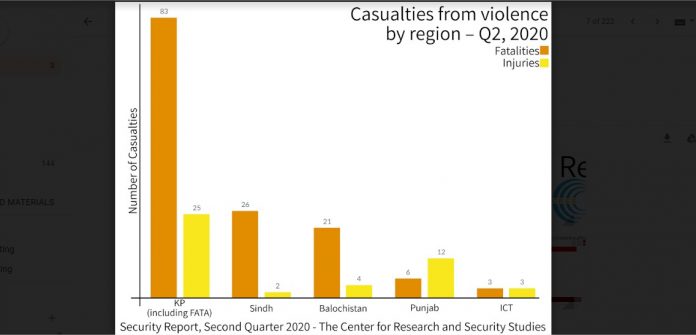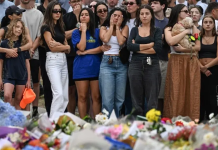Casualties from Violence in Pakistan
A total of 185 casualties were recorded during second quarter in 2020 (139 fatalities and 46 injuries). Khyber Pukhtunkhwa (KP) had the highest number of casualties followed by Sindh, Balochistan, Punjab, and Islamabad. There were no violence-related casualties reported from Gilgit Baltistan (GB) and Azad Jammu and Kashmir (AJK). Despite continued military operations, the former Federally Administered Tribal Areas (FATA) regions of KP continue to be militancy hot spots (table 01).
| Table 1: Casualties from violence by region – Q2, 2020 | |||
| Region | Fatalities | Injuries | Total |
| Khyber Pukhtunkhwa (KP) – including FATA | 83 | 25 | 108 |
| Sindh | 26 | 2 | 28 |
| Balochistan | 21 | 4 | 25 |
| Punjab | 6 | 12 | 18 |
| Islamabad Capital Territory (ICT) | 3 | 3 | 6 |
| Grand Total | 139 | 46 | 185 |
Compared to the last quarter’s figures, KP and Sindh appeared to be the only two provinces where fatalities from violence went up while the remaining provinces showed a significant decline (table 02).
| Table 2: Fatalities from violence by region – Q1 2020 vs. Q2 2020 | |||
| Region | Q1 2020 | Q2 2020 | % Change |
| Khyber Pukhtunkhwa (KP) – including FATA | 74 | 83 | 12.2% |
| Sindh | 9 | 26 | 188.9% |
| Balochistan | 40 | 21 | -47.5% |
| Punjab | 14 | 6 | -57.1% |
| Islamabad Capital Territory (ICT) | 3 | 3 | 0.0% |
| Total | 140 | 139 | -0.7% |
June was the only month when the fatalities from violence showed a marked uptick, the other two months, April and May, showed moderate decline in violence throughout the country (table 03).
| Table 3: Comparative data on fatalities by month – Q1 vs. Q2 2020 | |||
| Month | Q1 2020 | Q2 2020 | % Change |
| January 2020 vs. April 2020 | 53 | 44 | -17.0% |
| February 2020 vs. May 2020 | 54 | 51 | -5.6% |
| March 2020 vs. June 2020 | 33 | 44 | 33.3% |
| Total | 140 | 139 | -0.7% |
For the first time since the inception of this report in 2012, Quetta district experienced zero violence-related fatalities. North Waziristan, Karachi, Bolan, Makran, Bahawalpur, Buner, and Ghotki districts showed a significant increase in the number of fatalities from violence (table 04).
| Table 4: Fatalities by district – Q1 2020 vs. Q2 2020 | ||
| Districts/Agency/Region | Q1 2020 | Q2 2020 |
| N. Waziristan | 21 | 47 |
| Karachi | 8 | 18 |
| Bajaur | 9 | 8 |
| Bolan | 0 | 7 |
| Lakki Marwat | 6 | 7 |
| Makran | 0 | 6 |
| Panjgur | 3 | 5 |
| Bahawalpur | 0 | 4 |
| Peshawar | 6 | 4 |
| Buner | 0 | 3 |
| Ghotki | 0 | 3 |
| Islamabad | 3 | 3 |
| Kohat | 3 | 3 |
| Mohmand | 0 | 3 |
| Sukkur | 0 | 2 |
| Swat | 0 | 2 |
| Kurram | 0 | 2 |
| Badin | 0 | 1 |
| Bannu | 2 | 1 |
| Batkhela | 0 | 1 |
| Chakwal | 0 | 1 |
| Dukki | 0 | 1 |
| Jacobabad | 0 | 1 |
| Kalat | 0 | 1 |
| Kandhkot | 0 | 1 |
| Mastung | 0 | 1 |
| Rawalpindi | 7 | 1 |
| S. Waziristan | 0 | 1 |
| Tank | 10 | 1 |
| Quetta | 30 | 0 |
| Attock | 1 | 0 |
| Charsadda | 1 | 0 |
| D.I. Khan | 5 | 0 |
| Dir | 3 | 0 |
| Gujranwala | 1 | 0 |
| Harnai | 1 | 0 |
| Harnai/Naseerabad | 3 | 0 |
| Kech | 2 | 0 |
| Lahore | 1 | 0 |
| Mehrabpur | 1 | 0 |
| Muree | 2 | 0 |
| Nushki | 1 | 0 |
| Orakzai | 2 | 0 |
| Sargodha | 2 | 0 |
| Shangla | 1 | 0 |
| Swabi | 3 | 0 |
| Swat | 2 | 0 |
| Grand Total | 140 | 139 |
No suicide attack was reported during this quarter while encounters and ground operations carried out by security officials left a large number of outlaws dead. Gun violence, armed attacks, and lethal explosions caused the largest number of fatalities (table 05).
| Table 5: Comparative fatality data on violence/counter violence – Q1 2020 vs. Q2 2020 | ||
| Method of Violence | Q1 2020 | Q2 2020 |
| Gun violence (including target killings) | 26 | 31 |
| Ground operation/clashes | 29 | 40 |
| IEDs, Landmines, Hand Grenade Attacks, Other Explosions | 30 | 30 |
| Encounter with Law Enforcement Agencies (including suspected) | 35 | 22 |
| Armed attacks | 4 | 11 |
| Dead body found | 5 | 5 |
| Others | 1 | 0 |
| Suicide attacks | 10 | 0 |
| Total | 140 | 139 |
Like previous quarter, the fatalities of militants, insurgents, and criminals went up during the second quarter as well reflecting effective measures taken by the security forces. A sharp rise in the number of security personnel’s fatalities pointed to a retaliatory strategy of the outlaws – a situation further corroborated by the significant decline in the number of civilian fatalities during this quarter (table 06).
| Table 6: Fatalities by type of victims – Q1 2020 vs. Q2 2020 | ||
| Militants/Criminals/Insurgents | Q1 2020 | Q2 2020 |
| Militants | 39 | 41 |
| Insurgents | 3 | 11 |
| Criminals | 11 | 6 |
| Total Militant/Criminal/Insurgent | 53 | 58 |
| Percentage of total fatalities | 37.9% | 41.7% |
| Government and Security Officials | Q1 2020 | Q2 2020 |
| Security officials | 24 | 43 |
| Government officials | 1 | 1 |
| Total Government/Security Official | 25 | 44 |
| Percentage of total fatalities | 17.9% | 31.7% |
| Civilians | Q1 2020 | Q2 2020 |
| Civilians | 57 | 32 |
| Politicians | 0 | 3 |
| Media personnel | 2 | 1 |
| Religious party/persons | 2 | 1 |
| Foreigner | 1 | 0 |
| Total Civilians | 62 | 37 |
| Percentage of total fatalities | 44.3% | 26.6% |
| Overall Total | 140 | 139 |
Multiple insurgent groups from Balochistan and Sindh once again became active in the country and claimed responsibilities for several terror attacks that left 17 persons dead. Balochistan Liberation Army (BLA) claimed two attacks: one IED blast in Makran, Balochistan wherein an army major and five soldiers of the Frontier Corps lost their lives, and a daring attack at the Pakistan Stock Exchange in Karachi on 30 June 2020 leaving a policeman, three guards, and four insurgents dead.
An eight-year-old boy was killed and his father was seriously injured when their motorcycle hit a landmine planted by militants in Dasht-i-Goran area of Kalat District in Balochistan. Baloch Liberation Tiger (BLT) claimed responsibility for this explosion.
Two rangers and a civilian lost their lives in a bomb explosion at a meat shop near Ghotki Railway station on 19 June 2020. The same day, a civilian was killed when a hand grenade hurled near a paramilitary rangers mobile in Liaquatabad. One rangers official was injured in Larkana when a cracker was hurled at a security checkpoint. These three attacks were claimed by Sindh Revolutionary Army (SRA).
The militant group Hizb-ul-Ahrar (HuA), an off-shoot of the Tehreek-e-Taliban Pakistan (TTP), claimed responsibility for the killing of two policemen in the night of 26 May 2020 in the Chowrangi No. 26 area of Turnol in Islamabad (table 07).
| Table 7: Fatalities claimed by militant outfits – Q1 2020 vs. Q1 2020 | ||
| Claimants | Q1, 2020 | Q2, 2020 |
| Balochistan Liberation Army (BLA) | 0 | 14 |
| Tehrik-e-Taliban Pakistan (TTP) – Hizbul Ahrar (HUA) | 2 | 2 |
| Sindh Revolutionary Army (SRA) | 0 | 2 |
| Baloch Liberation Tigers (BLT)s | 0 | 1 |
| Baloch Raji Ajoi Sangar (BRAS) | 3 | 0 |
| TTP – HUA/Daish | 15 | 0 |
| Total | 20 | 19 |
Although no militant groups like TTP or Daish (Islamic State) claimed their responsibility for any violence during this quarter, there were eleven fatalities of militants that were reported to have affiliation with TTP (7) and Daish (4). The insurgent groups like BLA and Balochistan Liberation Front (BLF) also lost their activists in counter-violence operations carried out by the security forces. Among the security officials, the Pakistan army had the highest number of fatalities compared to other security forces. A large number of unidentified civilians were the victims of violence in addition to four missing persons who were found dead; two of them belonged to Jeay Sindh Qaumi Mahaz (JSQM), one was of Muttahida Qaumi Movement (MQM) – London, while one was unidentified (table 08).
| Table 8: Affiliation of victims – Q2 2020 | |
| Affiliation of victims | Fatalities |
| Militants/Criminals/Insurgents | |
| Militants – Unknown | 30 |
| Tehrik-e-Taliban Pakistan (TTP) | 7 |
| Balochistan Liberation Army (BLA) | 4 |
| Balochistan Liberation Front (BLF) | 4 |
| Daish (Islamic State) | 4 |
| Hazaro Kharoos Gang | 2 |
| Government and Security Officials | |
| Army | 25 |
| Police | 8 |
| Frontier Corps | 6 |
| Rangers | 2 |
| Post Office | 1 |
| Civilians | |
| Unknown/Missing | 33 |
| Tribal people | 5 |
| Jeay Sindh Qaumi Mahaz (JSQM) | 2 |
| Shia community | 2 |
| Daily Koshish Newspaper | 1 |
| Jamiat Ulema-e-Islam – Fazl (JUIF) | 1 |
| Pashtoon Tahafuz Movement (PTM) | 1 |
| Muttahida Qaumi Movement (MQM) | 1 |
| Total | 139 |
Sectarian Violence
Two persons lost their lives in Kurrum Agency of Khyber Pukhtunkhwa because of an explosion near an Imambargah in Lower Kurram’s Shoorki on 6 May 2020. No other regions of the country encountered sectarian violence during this quarter. Both victims were Shia, making them the only group targeted this quarter (table 09).
| Table 9: Fatalities from sectarian violence – Q2 2020 | |||
| Province | Fatalities | Injuries | Total |
| Khyber Pukhtunkhwa (KP) – including FATA | 2 | 1 | 2 |

















